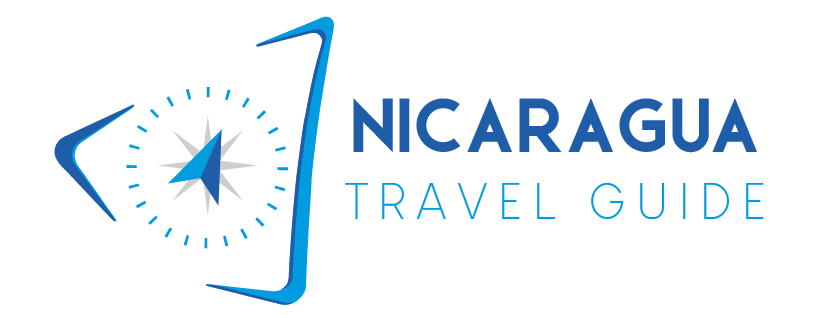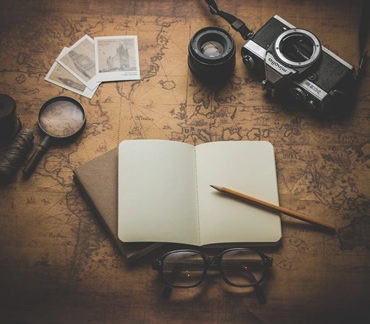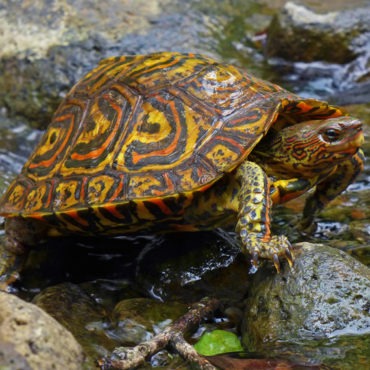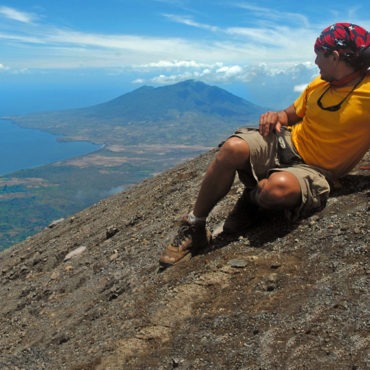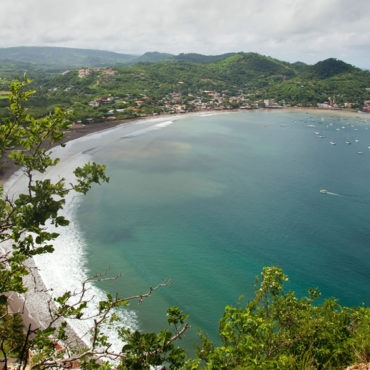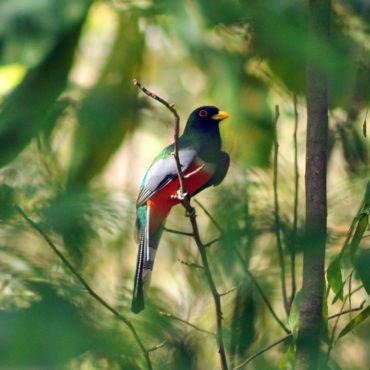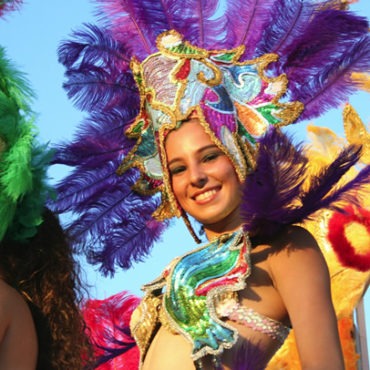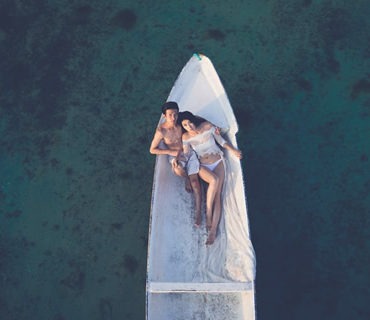Nicaragua Destinations
Nicaragua is a little known destination for most of the world’s travelers. This part of our web site was made to help you learn a bit in advance about what the country has to offer. It is a summary and is not meant to represent all of the possibilities for the visitor. Your specific interests could very well bring new destinations to the forefront. We can suggest these other locales based on your input. This Nicaragua country information page includes a summary of Nicaragua nature parks and reserves, the San Juan River, Nicaragua’s stunning volcanoes, Nicaraguan beaches, colonial cities and artisan villages.
Nicaragua Nature Reserves, Parks and Wildlife Refuges
Nicaragua has 78 nature reserves that cover more than 21,000 km2; the following list is a very brief summary of some of the parks which have enough infrastructure and nearby lodging to permit access to Nicaragua’s spectacular nature without wilderness camping.
Indio-Maíz Biological Reserve
Central America’s largest expanse of lowland rain forest reserve, called by UCLA biologists the finest rain forest nature reserve in Central America. The park in southeastern Nicaragua and is home to immense richness and biodiversity including many endangered species like jaguars and giant anteaters. Indio-Maíz is home to more than 400 species of birds, four species of wild cats and more than 200 species of reptiles. Lodging is limited to basic hotels along the San Juan River and the very comfortable and attractive Rio Indio Lodge at the end of the Rio San Juan.
Los Guatuzos Wildlife Refuge
A precious wetland, gallery forest and tropical wet forest wildlife park located on the southern shores of Lake Nicaragua and the western shores of the San Juan River. Most impressive in the reserve is the super rich bird life, but monkeys, sloth, caiman, iguanas and agouti are also common. Los Guatuzos is accessed in boat and most wildlife viewing is done via its small rivers and canals. Lodging is on the remote Solentiname Archipelago in Lake Nicaragua with two hotels available, both rustic, but feature private baths, home-cooked food and sterling locations.
La Flor Wildlife Refuge
This coastal sea turtle nesting site is visited by more than 30,000 olive ridley turtles annually making it one of the most important Pacific Ocean sea turtle nesting sites in the Americas. Turtle nesting season is August to December with peak months in October and November. Besides being a lovely Pacific Coast Beach, La Flor also protects tropical dry forest and mangroves. La Flor Wildlife Refuge is located on the southern Pacific seaboard along a earthen highway south of San Juan del Sur. Access is on a day trip from an attractive hotel in San Juan del Sur with use of 4×4 or by hiking from neighboring beach Playa El Coco and the rental homes and apartments there.
Mombacho Cloud Forest Reserve
Situated on top of the sleeping Mombacho Volcano, this lovely reserve has some of the most beautiful cloud forest flora seen anywhere in Latin America with numerous flowers, bromeliads and orchids amongst its 800+ species of plant life. The volcanoes slopes are home to more than 500 howler monkeys and some of the longer trails can help locate them in the trees. The park has the cleanest, best maintained trails in Nicaragua and if cloud cover permits stunning views of Granada, Lake Nicaragua and the Las Isletas Archipelago. Mombacho is easily visited from the fine hotels of colonial Granada 20 minutes by paved highway to the park entrance and then 30 minutes in the nature park truck to the summit.
Chocoyero Nature Reserve
This tiny reserve set in a narrow canyon is rich in wildlife, in particular the scandalous chocoyo (varieties of Pacific green parakeet) which nests along the canyon’s cliffs next to a tiny cascade. There are more than 800 chocoyos, as well as toucans, deer, howler monkey and agouti. The park’s tropical dry forest also hosts many hummingbirds and diverse flora. Chocoyero is located only 29 km from downtown Managua and best accessed via the wide selection of hotels there via a mixture of paved highway and a long winding dirt road that skirts pineapple and coffee farms.
Montibelli Nature Reserve
A private, family owned nature park in greater Managua and the Pacific basin’s best forest reserve for bird watching. The tropical dry forest of Montibelli is full of diverse flora and home to numerous mot-mots, trogons, manikins, hummingbirds and other species. There is also an impressive array of butterflies in the forest and a place to experience the pleasure of the personalized hospitality of the reserve’s kind owners. Access is from Managua and its hotels and via the same paved highway used to visit Chocoyero, though the earthen road that leads to Montibelli is shorter and better maintained than the road to Chocoyero.
Isla Juan Venado Nature Reserve
Part of the national park system and an important coastal wetlands reserve. The barrier island of Juan Venado is 22 km long and a half km wide. The ocean side is a nesting site for sea turtles while the protected side estuary is home to many water fowl, iguana, crocodile and caiman, as well ecologically important mangroves. The reserve can be explored in motorboat or kayak. Access is via the fine hotels of León just 30 minutes away via paved highway.
Selva Negra Cloud Forest Reserve
A private reserve in the northern province of Matagalpa. The forest is part of an organic shade coffee operation and hotel project owned by third generation Nicaraguans of German origin. The forest is great for hiking, though wildlife tends to be difficult to spot. Howler monkeys are usually nearby, as well as several species of birds not found south of this mountain range. The coffee hacienda is 100% ecologically sustainable and part of the attraction for its perfect marriage of idealism and practicality. Both currents of thought keep 1/3 of this big property forest reserve and lead to the recycling of everything down to the soapy dishwater. Lodging is cabins located at the edge of Selva Negra’s forest reserve overlooking one of the property’s 8 ponds. Selva Negra is located 2 hours and 20 minutes north of Managua.
Nicaragua Volcanoes
All of Central America is blessed with beautiful volcanic cones, mountains of testament to our earth’s immense power and its living, breathing interior. Nicaragua’s volcanic chain is one of the most impressive on the isthmus due to beauty of the cones and the fact that all of the more than 50 cones (7 active which are active) rise off of a flat coastal plain that lies just above sea level. This gives the Nicaraguan volcanoes a starkly dramatic profile and makes them accessible to climbers, hikers and walkers.
Cosiguina Volcano
Is in the province of Chinandega and located at the very northwestern-most point of Nicaragua and its stunning volcanic range. At 800 meters above sea level, the 3-5 hike up to its crater lip provides an unforgettable view of the Golf of Fonseca and its islands, not to mention the pristine crater lake sleeping inside Cosiguina’s steep interior walls. The forest reserve that wraps the cone is home to Scarlet Macaws and other species that are rare finds on Nicaragua’s Pacific slope. The volcano can be accessed from the efficient business hotels of Chinandega located 3 hours northwest of Managua or from a rustic lodge on its flanks located 2 hours from Chinandega.
San Cristóbal Volcano
An active volcano located in the province of Chinandega and Nicaragua’s highest at 1,745 meters above sea level. San Cristóbal is located outside the city of Chinandega and has been in constant eruption since 2001. One of the most symmetrical and handsome of the Maribios Volcano Range, San Cristóbal is a difficult climb that should be reserved for hikers in very good condition, though 4×4 access to the adjacent Casitas Volcano means that lesser athletes can also reach the summit. It is best accessed from the city of Chinandega.
Telica Volcano
Is in the province of León and located in the north-central part of the Maribios Volcano Range. At 1,061 meters above sea level Telica Volcano is easily recognizable for its bald eroding west face and lightly smoking crater. Telica is active with its last significant eruption occurring in 1999. There is a long but rewarding hike around its east face to the summit that affords a breathtaking view of the vertical interior walls of its crater. The hike can take 3-5 hours if retuning to the place of departure or can continue to the village of San Jacinto next to the Santa Clara Volcano. The complete hike takes 6-8 hours and involves separate three ascents. Access is from the fine hotels of León 30 minutes away or a simple home lodge in the village of San Jacinto.
Cerro Negro Volcano
Is in the province of León and located in the middle of the impressive Maribios Volcano Range. At just 450 meters, little and very active Cerro Negro deceives those who underestimate it ferocity. One of the newest volcanoes to burst forth in the Americas, Cerro Negro is a huge pile of black sand and gravel, wrapped in dried lava and rocks that it spit out of its center in 11 harsh eruptions in the 20th century. The last of which in 1999 opened up 3 baby craters at its base. The climb of Cerro Negro is on its north face and can be done in one hour. The descent of Cerro Negro can be done by a form of foot-sliding and dancing down its sandy and steep west face. The cone can be accessed via the good hotel selection of León reached by a 50 minute driver on a long earthen country road.
Momotombo Volcano
Is in the province of León and located at the southern tip of the Maribios Volcano Range. At 1,300 meters above sea level it is one of Nicaragua’s most beautiful volcanoes with a symmetrical cone that towers over the shores of Lake Managua. The volcano has been an inspiration to both national and international poets over the centuries and sports a geothermal plant at its base. The climb is a long one, normally taking two days with camping just below the end of the tree line. The smoking cone is active, but it has not seen a big lava flow since 1905. Access to the base of the volcano is from either León or Managua, both with fine hotel options 1½ hours away.
Masaya Volcano
Is in the province of Masaya and could be the most accessible active volcano in the world. A paved road runs to the summit of the smoking Santiago crater, just 29 km from the center of new Managua. The park’s maximum elevation is 635 meters above sea level measured from the extinct cone of San Fernando where views of the lake valley are priceless. The ancient caldera houses more than 7 volcanic cones and a crater lake, all of which are protected by the Masaya Volcano National Park. The park’s landscape is a Martian or moonscape and its most famous residents are the crater dwelling parakeets which live in the toxic inner walls of the active Santiago crater. Santiago’s last eruption was in April of 2001.
Apoyo Volcano
Shared by the provinces of Masaya and Granada. This dormant cone last erupted about 20,000 years ago and has been filling with clear, Mediterranean blue water ever since. Laguna de Apoyo or Apoyo Crater Lake is the biggest of Nicaragua’s spectacular 14 lake filled craters and has good lodging along its shores, as well as access from good hotels in Managua (1 hour) and Granada (30 minutes). The interior of the crater is a nature reserve and home to more than 145 species of birds, howler and white face monkeys and rare species of fish.
Concepción Volcano
Is in the province of Rivas and located in the western part of massive Lake Nicaragua on the Island of Ometepe. At 1,610 meters above sea level Concepción Volcano is Nicaragua’s second highest volcano and many believe the most beautiful in Nicaragua. The volcano slopes are a nature reserve, home to deer and monkeys, as well as numerous legends. Concepción last big lava flow was in 1957, but ash and smoke eruptions occurred as recently as 1999. The volcano is a one day climb of 7-9 hours and for the very athletic, but its forested slopes can be enjoyed with a complete ascent. Rustic, but good lodging is available on Playa Santo Domingo which affords easy access to the east face of the mountain after a 30 minute ride in 4×4.
Maderas Volcano
Is in the province of Rivas and located on the Island of Ometepe in Lake Nicaragua. At 1,394 meters above sea level, Maderas is usually draped in mist, the vital liquid of its rich cloud forest reserve. Maderas Volcano is the sleepy twin of Concepción and home to a much more diverse and less disturbed flora and fauna that includes healthy populations of howler monkeys and Amazon parrots. There are two popular hikes on the mountain, the first a fairly easy walk up the west side of the volcano through farm land and then cloud forest ending at a spectacular mountain cascade of more than 40 meters. Average hiking time varies from 1-3 hours up and 1-2 hours down depending on starting point. The second option is a summit hike that is muddy and trying, but less physical than the ascent of Concepción. Normal climbing time is 3-5 hours with a 2-4 hour descent. At the summit is a misty, ice cold crater lake. This seemingly extinct crater can be accessed by the same rustic but charming lodging on Playa Santo Domingo located 1 hour from the cascade trail head and 30 minutes from the summit hike trail.
San Juan River, Nicaragua
The San Juan River is a timeless passageway through dense tropical forest from Central America’s grandest lake to the Caribbean Sea. This historic river was the route of famous pirates and later the stage for great colonial period battles between the Spanish and British Crowns. It later became the route of Cornelius Vanderbilt’s inter-oceanic steam ship service during the California gold rush. The Rio San Juan, described by Mark Twain in his notebooks as “an earthly paradise”, is one of the most enjoyable and rewarding rain forest experiences available anywhere. The 190 km length of the San Juan River, from the inland sea of Lake Nicaragua to the Caribbean is full of fabulous flora and fauna, including the Indio- Maíz Biological Reserve, 4,000 square kilometers of virgin rain forest and wildlife. The Indio-Maíz reserve has been described by University of California biologists as “the gem of Central American nature reserves”. The San Juan River affords access to the Indio-Maíz Biological Reserve, home to many endangered species: howler, white faced and spider monkeys, jaguar, giant anteaters, crocodiles, toucans, parrots and a rainbow of orchid and butterflies. Over 600 species of birds live here, along with more than 300 species of reptiles and 200 species of mammals. This is the lungs of Central America, the biggest expanse of tropical lowland rain forest north of the Amazon basin. Lodging on the San Juan River includes simple river front lodges at the mouths of the Río Sábalo, Río Bartola and Río Sarapiquí, though the superior lodge is in the Bay of San Juan at the end of the Río San Juan.
Artisan Villages
Nicaragua’s culture can be experienced in many ways. One of the best opportunities is in the rural areas by visiting the homes that double as workshops for the artisan handicraft makers of Nicaragua in Masaya and its surrounding colonial villages known as Los Pueblos de la Meseta or in the northern mountains.
Masaya City
This overgrown village is considered the cradle of folklore in Nicaragua and for good reason. Masaya good be the richest crafts center in Central America. Famous for its restored 19th century open air artisan market, every street in Masaya’s indigenous Monimbó neighborhood is home to at least one artisan workshop. The town’s residents are best known for their hammocks, but handmade leather, wood and fabric products are also prevalent. The visitor will often by amused to find the artisans of Monimbó making crafts that carry the name Honduras, Costa Rica, Panama and even Guatemala. The reason is simple, much of the “native” crafts of those countries are made in Masaya by the artisans of Monimbó. Masaya can be visited from Managua or Granada hotels just 30 minutes away.
Catarina
This little colonial period village is a quiet town perched on the lip of the Apoyo Crater Lake is best known for its nurseries which overflow onto the streets with potted plants and flowers. The visitor will also encounter bamboo basket weavers and wood workers. Catarina can be visited from Managua (one hour) or Granada (30 minutes) hotels.
San Juan de Oriente
The most famous ceramic village in Central America that sports a restored 16th century church. The populace of this indigenous village has been making ceramics for more than 2,000 years and 85% of its population is working today in pottery production. The town’s beautiful earthenware is now known around the world and a visit to one of the humble workshops is a rewarding experience for lovers of ceramics or visitors interested in cultural interaction. San Juan de Oriente is next to Catarina.
Masatepe
Every visitor to Nicaragua marvels at its handmade wooden rocking chairs, standard equipment in homes countrywide. Most of these wood and wicker rockers as well as many other fine furniture pieces are made in the cool highland village of Masatepe. A visit to a workshop reveals how such fine work is made with basic tools and the unselfish nature of the Nicaraguan artisan who shares his knowledge (and tools) with family, friends and neighbors. Masatepe is located just 15 minutes from Catarina and San Juan de Oriente and can be visited from the fine hotels in Managua and Granada.
Condega
Set in a broad highland valley of the northern mountains, this sleepy village is home to some of Nicaragua’s most beautiful red-clay pottery. The production of the ceramics is what gives Condega its name, indigenous for “land of pottery”. The most beautiful of the earthenware is produced by a woman’s cooperative in a tiny settlement of red clay homes near the village proper. The village can be visited via hotels in Matagalpa (2 hours), Managua (3 hours) or León (3 hours).
Jinotega
The peaceful coffee town surrounded by mountain peaks with a gorgeous whitewashed Cathedral is also one of two sources of Nicaragua’s indigenous black ceramics. Outside of Jinotega on the highway to San Rafael del Norte is a tiny settlement that time has forgotten, where the work of black pottery specialists can be seen as the spin clay in a local cooperative. Jinotega is 3 hours north of Managua and has a good hotel. The cooperative is 30 minutes from Jinotega.
Matagalpa
The capitol of coffee production in Nicaragua also hides some interesting crafts in its labyrinth of hilly streets. There are both black ceramic and textile cooperatives that can be visited in and around the city. The natives of Matagalpa once were prolific in cotton textile production and this tradition. This custom was lost during the Pacific basin cotton boom years, but is slowly returning. Matagalpa is 2 hours north of Managua.
Camoapa
Set deep in the cattle and cowboy region of Boaco, this seldom visited corner of Nicaragua makes a Nicaragua version of Panama hats. Although the tightness of the weave is not as refined as the famed hat makers of the northern Andes of Ecuador, Camoapa hat weavers are very accessible and friendly and happy to explain their unique talents to visitors. Camoapa is located 2 hours east of Managua.
Nicaragua Pacific Coast Beaches
Nicaragua’s Pacific Coast is blessed with kilometers of pristine undeveloped coastline. This is slowly changing, but many of the beach projects are ecologically friendly and there appears to be reason to hope that Nicaragua can develop beach tourism without razing the coast and planting concrete jungles. Below is a very small sampling of what is available to date, though much more is planned, so please inquire of what’s new if you are interested in beach time without beach crowds.
Las Peñitas
This is a wind and wave swept beach that is often ripped by strong currents. The coast is full of pelicans here playing in the drafts of the waves and if the waves are not too strong some good swimming in warm water can be had here. The seafood and sunsets are excellent and this makes Las Peñitas a great day or half-day trip from León’s fine lodging options just 30 minutes east of the beach.
Montelimar
A beach resort with all inclusive service located just over 1 hour from Managua. The resort is built around a farm with interesting political history and although it is fairly mainstream; those who want to do nothing but relax and eat have found their spot. The beach is long and deep with dark gray sand and a long gradual sandy shelf that extends well into softly breaking waves. Montelimar Resort is located 1 hour and 20 minutes east of Managua.
Morgan’s Rock
this south coast beach hotel is Nicaragua’s entrance in the heady world of sustainable Eco-friendly beach hotels, built on a private beach reserved for hotel guests only. Opened to the public in July of 2004, the all inclusive hotel has a reforestation project, a private nature reserve and educational programs to mix with great beach relaxing and the luxury in its private cabins. The beaches of this zone of Nicaragua’s coast are the finest on Central America’s Pacific Coast. Access is via San Juan del Sur (30 minute), Granada (2½ hours) or Managua (3 hours), using a mixture of paved highways and dirt roads, the latter of which are slated be improved.
San Juan del Sur
A broad half-moon bay on Nicaragua’s southern Pacific Coast, San Juan del Sur as long since been discovered by international travelers and its popularity is by and large well deserved. The beautiful bay is good for swimming, though the water is a bit chilly by Nicaraguan standards. There are numerous lodging and eating options along the waterfront and the town is an excellent base for exploring other less known beaches in the region via motorboat. San Juan is 2½ hours from Managua or 2 hours from Granada.
Playa El Coco
Is a long tan colored cove backed by forest and caressed by medium sized waves. Playa El Coco is the only lodging close to the very special sea turtle nesting site of La Flor Wildlife Refuge, just a 20 minute walk south of the beach. The ocean is a very refreshing temperature here and the forest is quite lush during the rainy season. Lodging is one of the best reasons to come, with a wide variety of rental homes and apartments available with daily cleaning service, internet, general store and a beach front restaurant. El Coco is 30 minutes from San Juan del Sur and 2 hours from Granada.
Corn Islands – Nicaragua Caribbean
The Nicaragua Caribbean islands of Corn Island have now become world famous as a throw-back to the Caribbean islands of days gone by. Tours Nicaragua first started sending our guests to Corn Island in 1996 and we know the islands very well with frequent visits to both the big and msall islands. We are happy to offer a range of different trips that include either Big Corn or Little Corn or both. We think the experience is worthwhile. Particularly due to the fact that Great Corn Island is now served by much better airplanes than in the past with ATR-42 running the MGA Corn Island route for La Costeña, Nicaragua’s national airline. In addition local hotels have improved in both Great Corn Island and Little Corn Island. Please contact us about putting together a vacation package to the Corn Islands or including Corn Islands in your trip to other parts of Nicaragua. Those travelers interested in snorkeling and/or diving will want to spend at least part of their time on Little Corn, which is sleepy and has superior reefs and diving and snorkeling options. Great Corn Island has the advantage of much more island life, ease of movement with taxis running around the one road on the island to any restaurant for a dollar per person, as well as more comfortable hotels and more island culture. We love both islands and ask that you express your interests so we can best recommend one of the Corn Island or both.
Surfing in Nicaragua
Nicaragua has been called by international surf tour operators “the next surfing frontier”. The publicity that Nicaragua surfing is now receiving is long overdue, though international hype singing the praise of Nicaragua surfing can be a double-edged sword. How can you spread the good word and not damn the waters with too many surfers? Nicaraguans have little worry and normally view with pleasure the publicity the Nicaragua coast and surf spots are receiving, and visitors are good for Nicaragua’s tiny economy.
It is easy to worship Nicaragua’s more than 250 km of Pacific coastline for its natural beauty, clean water, villages of friendly fishermen, as well as the 90% consistent SW and S swells. The average height of the Nicaragua Pacific swells are 4-6 feet, though even on small days 2-3 feet is normal, and when it is big, 15 feet does not surprise. The best time of year to surf is March through November however December through February is still very good, if less consistent. Aside from 300+ days of offshore winds, consistent swells and a broad choice of breaks, Nicaragua still boasts the least crowded waves in Central America. Yet, the southern coast of Nicaragua’s Pacific coastline has now apparently been “discovered”, hence the arrival of the big international surf tour companies to the south coast, drawing surfers from around the world and up from our over-saturated southern neighbor Costa Rica. Paradise is getting a bit crowded, at least by Nicaraguan standards.
Nicaragua Colonial Cities of León and Granada
Although Nicaragua is blessed with numerous historic colonial villages it is Nicaragua’s two colonial cities of Granada and León which have brought it much fame and numerous visitors from around the globe.
Granada –
or the “Gran Sultan” is one of Latin America’s most beautiful colonial cities. This ancient town founded in 1524 on the shores of mighty Lake Nicaragua is full of history and Spanish colonial charm and is famed as one of the oldest European settlements in the western hemisphere. The city’s precious architecture and history is unforgettable as is lodging in a beautifully restored colonial home at one of its fine hotels. There is not more famous destination inside Nicaragua, with visitors coming from around the world to enjoy its timeless beauty and quiet charm. Granada is also a great jumping off point to visit numerous nature reserves, beaches and villages in the region.
León –
set between the Pacific Ocean and a jagged range of active volcanoes León was Nicaragua’s colonial capitol for 297 years. This city is home to more than 12 colonial period churches, each one unique in its design from tiny parish size chapels to the mighty Cathedral, Central America’s largest church. León is also the home of Nicaragua’s greatest passion, poetry, the origin of numerous internationally renowned poets, including the national hero Rubén Darío, considered one the Spanish language’s 5 greatest literary figures. León has two very good hotels, and is perfect for setting off to visit Nicaragua’s Maribios Volcanoes for hiking or kayaking the Juan Venado Nature Reserve.
Facts for Nicaragua
A Glossary of Facts about Nicaragua
Dry Tropical Forest
This very unique eco-system includes many beautiful flowering trees. The plant life must be able to withstand 6-7 months of hard tropical rains and then 5-6 months of almost no rain at all. Good examples are the Nicaraguan nature reserves of Chocoyero and Montibelli.
Gallery Forest
So called for its great wildlife viewing qualities. The gallery is a line of trees, often growing out of sediment build up along river banks. Behind this line of trees is wetlands that do not support forest. The river bank trees are well lit and wildlife relatively easy to spot. Good example is in the wildlife refuge Los Guatuzos.
Cloud Forest
A broad term for forest above 1,000 meters in the tropics that is often draped in clouds and is usually very diverse due to altitude variations that create specific micro-systems at each altitude. Good example is the forest reserve on the Mombacho Volcano.
William Walker
19th century North American lawyer/journalist turned adventurer who sought to expand the pre-civil war United States into Central America by setting up a slave state in Nicaragua. He invaded with a small but well armed force in October of 1855, named himself president of Nicaragua in July of 1856, but only held control of Granada and other select parts of Nicaragua briefly before being expelled by combined Central American armies in early 1857. The first Nicaraguan victory of against Walker’s army occurred on the 14th of September 1856 and is celebrated annually as a national holiday.
Mark Twain
Legendary writer/humorist who traveled across Nicaragua at the end of 1866 on the way from San Francisco to New York, his views on Nicaragua and the Vanderbilt steamship line that provided the journey are recorded in the book, Travels with Mr. Brown. Twain was particularly impressed with the beauty of the Nicaraguan people, the Island of Ometepe and the San Juan River.
Rubén Darío
Founder of the modernist movement that rejuvenated Spanish prose and poetry at the end of the 19th century. A child prodigy who began writing poetry at 11 years old and is now remembered as Nicaragua’s greatest national hero. He has a small village named after him in the province of Matagalpa where he was born, but spent his childhood years in Leon where his house is now a museum.
Howler Monkey
called mono congo in Spanish, this vocal tree dwellers can be heard as far as 5 km away. The male is the one who actually howls. They are considered an endangered species in much of Central America. They are found in many places in Nicaragua, including the reserves of Chocoyero, Mombacho Volcano, Laguna de Apoyo, Ometepe Island’s volcanoes, La Flor, Indio-Maíz, Los Guatuzos, Solentiname and over great areas of the eastern and northeastern Nicaragua. There is no better place to take monkey pictures than Nicaragua, though the challenge of backlighting and dark animals is usually a formidable one.
Cacao
The raw fruit from which chocolate is made. The seeds of the fruit are dried and crushed. Less common in Nicaragua since the war years from 1979-1989. When the Spanish arrived it was plentiful, especially in Rivas. The indigenous Nicaraguans used the fruit as their monetary unit.
Nacatamal
A traditional Nicaragua dish eaten at any time of day, though more readily available Friday-Sunday in cities. Normally made of pork (though chicken is also used), rice, corn meal and sweet peppers, then wrapped in a big plantain leaf and boiled.
Guapote
Native large-mouth lake bass, found in ponds and lakes all over Nicaragua. This is perhaps the finest fish to eat in Nicaragua, usually fried whole and drenched in tomatoes and onions.
Fresco
Short for refresco and usually referring to freshly made fruit drinks which consist of the fruit, water and sugar.
Indio-Maíz Biological Reserve
One of Central America’s finest rain forest reserves with nearly 4,000 km2 of primary rain forest. The reserve is home to a staggering bio-diversity that only a virgin tropical rain forest can produce. Access is limited, but the reserve can be visited via the San Juan River in southern Nicaragua.
Las Isletas
Located in Lake Nicaragua, a compact 354 island archipelago formed around a peninsula, both or which are products of a pre-historic eruption of the nearby Mombacho Volcano. Most are inhabited and home to a mixture of humble fishermen and some of Nicaragua’s most wealthy families who have vacation or party homes there.
Los Maribios Volcanoes
Western Nicaragua’s most active and dense chain of volcanoes, more than 21 in all, 5 of which are active. They run from Cosigüina on the shores of the Gulf of Fonseca to Momotombito in Lake Managua. They draw their name from an indigenous group which inhabited the area at the time of the Spanish conquest.
Mombacho Volcano
Long dormant, this cone shadows the colonial city of Granada and is home to a well kept cloud forest reserve and two popular canopy tours. A collapse of part of its main crater destroyed what was Granada’s twin city on its south flank in the late 16th century.
Los Guatuzos Wildlife Refuge
A small and spectacular wetlands and gallery forest reserve on the southern shores of Lake Nicaragua and part of the San Juan River. The finest place to view wildlife for those short on time, it can only be accessed by boat. It names comes from the indigenous group who inhabited the rivers and forests of the reserve until the mid-19th century.
Masaya
The name of both the province and its principle city. Masaya is the most densely populated region in Nicaragua and home to some of its best kept traditions which includes the making of the world’s finest hammocks. The city has a late 19th century open-air market which has been restored and is a fine place to shop for local made goods.
Masaya Volcano National Park
Home to five cones and an active crater, Santiago, which last erupted in April of 2001. The park is great for hiking with sweeping vistas. The most famous of its wildlife are the crater dwelling parakeets which defy the toxic environment of Santiago crater to nest away from predators.
León
León, Nicaragua was founded in its current location in 1610. León was the colonial capital of Nicaragua until independence from Spain in 1821. Since then it has continued as a university town, home to intellectuals, revolutionaries and poets. The city of León, Nicaragua has more than a dozen charming colonial churches within 8 blocks of the city center and houses the biggest temple in Central America, the Cathedral of León, 113 years in the making.
Granada
Granada, Nicaragua, founded in 1524, is one of the oldest European settlements in the Americas. Granada was the economic capital of Nicaragua in colonial times, the scene of William Walker’s failed attempt at North American re-colonization. Granada is now rapidly becoming famous on the world stage as the most important tourism destination in Nicaragua for its lake front beauty and splendid colonial homes.
Corn Island
Two small islands located 20 minutes by air east of Nicaragua’s Caribbean coast. Visited by Christopher Columbus in 1502, they are now inhabited by a mix of Afro-Caribbean’s and Miskito Indians who live mostly from fishing for lobster. The islands are lined by fine white sand beaches and coral reefs.
Selva Negra
Spanish for black forest, a private organic coffee plantation, cloud forest reserve and hotel owned and operated by descendants of German immigrants. The reserve is home to howler monkeys and a rich bird life.
San Juan River
190 km in length, this water passage between Lake Nicaragua and the Caribbean Sea is the closest thing to a natural canal between the world’s two great oceans. The river has a 17th century Spanish fortress used to fend of pirates and the Indio-Maíz Biological Reserve as its principle attractions.
Ometepe Island
Located in western Lake Nicaragua, Isla de Ometepe it is made up of two volcanic cones, one active, Volcán Concepción and the extinct Volcán Maderas. Both the cones of Isla de Ometepe have nature reserves and the isthmus connecting the two volcanoes has a long sandy beach. Isla de Ometepe has been inhabited for at least 3,000 years and houses more than 600 archeological sites.
San Juan del Sur
Located on the southern shores of Nicaragua’s Pacific Coast, this half-moon bay is quickly becoming the darling of foreigners escaping over-developed Costa Rican beaches just to the south. First visited in 1523 by the original Spanish expedition it is now a popular vacation spot for Nicaraguans and visitors. Nicaragua rental homes are also available near San Juan del Sur, in the nearby home rental complex of Playa El Coco.
San Jacinto, León
A small village set in the center of the Los Maribios Volcano Range with an interesting fumarolic field located right on the northern border of the settlement. Known locally as Los Hervideros de San Jacinto the fumaroles have formed micro-craters of varying size, color and shape. The village is shadowed by the active Telica Volcano, and extinct cones Volcán Santa Clara and Volcán Rota.
San Juan de Oriente
An ancient Chorotega Indian village that became a Spanish colonial settlement in the 16th century. The village is famous internationally for it fine earthenware. The population’s ceramic tradition pre-dates the Conquest and their pottery can be found in stores from San José, Costa Rica to Rome. It is located in the province of Masaya and is part of the infamous Los Pueblos de la Meseta.
Pueblos Blancos
Spanish for “White Villages” most of the homes are actually painted in bright colors. Also called Los Pueblos de la Meseta or Mesa Villages. Most of these precious colonial period villages were built on top of important Chorotega Indian settlements. They are located in the provinces of Masaya, Carazo and Granada and are famous for their superb handicrafts.
Canopy Tour
Use of mountaineering techniques to explore the upper reaches of the forest normally not seen by humans. The customer buzzes in between large trees landing on tree platforms and using metal cables with safety equipment. Nicaragua has plenty of canopy tours, the best being on the Volcán Mombacho. Although many advertise that their canopy tour is in rainforest canopy, most are in either cloud forest or tropical dry forest ecosystems.
Francisco Hernández de Córdoba
The Spanish military captain who defeated indigenous armies and established León and Granada in 1524. The monetary unit of Nicaragua carries his name. He was beheaded in 1526 in the Plaza Mayor of León Viejo due to suspected plotting against Nicaragua’s first governor.
Nicaraos
Popular term used to describe the wealthiest and most developed indigenous culture at the arrival of the first Spanish explorers in 1523. Now more frequently referred to as Nicaraguas, they were named after the royal chief Niqueragua, whose subjects populated the isthmus between Lake Nicaragua and the Pacific Ocean, today’s province of Rivas, Nicaragua.
Cocibolca
The most popular of one many supposed indigenous names for the body of water known today as Lake Nicaragua. Lake Nicaragua is Latin America’s second largest lake and punctuated by more than 400 islands. Its waters drain via the San Juan River to the Caribbean Sea.
Chocoyero
Nicaraguan for “place of many parakeets”, a tiny tropical dry forest reserve with two cascades and a rich flora and fauna. The reserve is home to over 700 nests for Pacific green parakeets, known locally by their indigenous name Chocoyos. It is located just 40 minutes from downtown Managua, 4×4 is necessary.
La Purisima
Also known as La Gritería. A religious tradition unique to Nicaragua used to pay tribute to the Virgin Mary. Believers ask for assistance from Santa María and in thanks build small altars in front of or just inside their homes on the 7th of December. Roaming groups of worshipers visits the numerous makeshift alters singing songs to the Virgin and receiving small gifts of food in return. The festival in León from the early 18th century and is now celebrated countrywide.
El Hipico
Part of every patron saint festival, this is a parade of the horses carrying well dressed and heavy lubricated riders from around the province of the festival and countrywide.
Augusto César Sandino
One of Nicaragua’s biggest heroes, Sandino was a nationalist and early opponent of globalization. He became the namesake for the FSLN, Frente Sandinista de Liberación Nacional, Sandinista National Liberation Front. Augusto Sandino was a Liberal Party general who fought a guerilla war in the northern mountains against the occupation of Nicaragua by the US Marines from 1927-1933. He signed a peace treaty with the Nicaraguan government soon after withdrawal of the Marines, one year after signing the treaty he was abducted and killed in Managua.
Nicaraguan Dress
Typical Nicaraguan dress is cotton pants and shirt for men and skirt with blouse for woman. In the cities most Nicaraguan dress as elegant as possible, while more casual dress is the norm for the beaches and mountains. Our visitors are given more specific suggestions for Nicaraguan dress ideas depending on the travel itinerary chosen.
Nicaraguan Animals
Nicaragua is home to many endangered species of animals, such jungle wildlife as howler, white faced and spider monkeys, jaguar, giant anteaters, crocodiles, toucans, parrots are examples, as well as a rainbow of orchid and butterflies. Being located right in the heart of the tropics at between 11°-15° north of the equator means that the jungle wildlife and Nicaraguan animals are numerous and diverse. A good example is Nicaragua’s Indio Maíz rainforest biological reserve which has more than 600 species of birds, 300 species of reptiles and 200 species of mammals.
Nicaraguan Dances
One of the real pleasures for the cultural visitor is the variety and popularity of Nicaraguan dances. Unlike many countries that only perform folkloric dances for nostalgia and anthropological studies, Nicaraguan dances are part of every day life for most Nicaraguans. In Masaya, for example, there are more than 100 folkloric dance companies, all performing the broad variety of traditional Nicaraguan dances. Most of the Nicaraguan dance styles are heavily influenced by the 297 year colonial Spanish period, though African and indigenous elements are present, especially in Nicaraguan dances from the Caribbean coast.
Nicaragua Tourism Attractions
Nicaragua has more tourism attractions that most Europeans and North Americans imagine. It would be very easy to spend 3 weeks touring Nicaragua without boring oneself from all the tourism attractions. Please see our Country Information page on this site for information on the many tourism attractions in Nicaragua.
Surfing Nicaragua
Many come to Nicaragua for its surfing. Much like Costa Rica where surfers opened up the country to international tourism, surfing in Nicaragua is now leading the way to a giant influx of international backpackers. Surfing in Nicaragua is limited to the waves of the south and central Pacific Coast, but the wave selection is truly top quality, and those who have surfed Nicaragua rave at the empty breaks, long tube rides and laid back life style along the Nicaraguan coast. The only downside to surfing Nicaragua at this point is the lack of road infrastructure to reach many of the countries best waves and breaks. Charter boat is a costly but effective solution, though there are some select spots that the waves can be surfed directly in front of decent coastal lodging.
Nicaraguan Art
Nicaraguan Art is little known outside of Central America but is as vibrant as the Nicaraguan landscape. Though most modern Nicaraguan art galleries are located in Managua, Granada and León also has galleries dedicated to display of Nicaraguan art. Please ask us if you have interest in viewing Nicaraguan art and we will include it in your visit.
Flor
Flor is a key word for most visitors to Nicaragua. Not only is flor (Spanish for flower) visible in all parts of the country in its natural state and the name of Nicaragua’s most famous turtle nesting site Playa La Flor, but the world’s best rum, Flor de Caña is made in Nicaragua, comes in 7 flavors, aged up to 21 years. Flor de Caña means Flower of the Cane, a long willowy flower that tops the sugar cane shortly before it is ready to be harvested.
Mar
Mar is Spanish for sea and although the Pacific is an ocean, most Nicaraguans refer to both bodies of waters: the Caribbean Sea and the Pacific Ocean as mar. In fact it has been said that Nicaragua is pleased with three seas. As the great Lake Nicaragua was called by the Spanish El Mar Dulce or the fresh water sea.
Hotels San Juan del Sur
San Juan del Sur has a broad selection of hoteles for everyone from the backpacker to the sophisticated ecotourist. The hotels of San Juan del Sur all raise their rates dramatically for Holy Week and Christmas periods so it would be wise to avoid visits during these holiday periods when choosing hotels in San Juan del Sur.
Nicaraguan Culture
Nicaraguan Culture could be described as one of the most authentic mestizo cultures in all of Latin America. While many define culture as either highbrow European culture or ethnic indigenous traditions, Nicaraguan culture is a blend of the two worlds, a mixture that has lived for many years outside of the big cultural blender called globalization. The most obvious effect of the preservation of Nicaraguan culture for the visitor is the Nicaragua people’s warm hospitality and great kitchen.
Miskito Indians
Nicaragua is home to the majority of infamous Miskito Coast, home to the Miskito Indians, shared by southeastern Honduras. The Miskito Indians are thought to have originally been migrants from northern Colombia and eastern Venezuela, perhaps arriving about 4,000 years ago. Today’s Miskito Indian is a mixture of Afro-Caribbean and indigenous cultures and the language of the Miskito Indians has a great number of English words adapted from the many years in which Great Britain was their trading partner.
Nicaragua Vacation
Vacations in Nicaragua are becoming less and less of a surprise to the international market, in particular the US traveler has begun to realize that vacations in Nicaragua are not only unique but highly attractive with Nicaragua being high on the vacation list for holidays. The idea of a Nicaragua vacation no longer brings chuckles and head-scratching from fellow workers in the office. The options for a Vacation in Nicaragua are numerous, whether it be a Nicaragua beach vacation, eco tour vacation in Nicaragua or an adventure vacation in Nicaragua that includes both sports and either culture or nature or all the above. That is one of the great advantages of a vacation in Nicaragua, the traveler can combine not only ecotourism and adventure, but also cultural tourism, making Nicaragua one of the region’s most attractive vacation destinations. We invite you to consider a Nicaragua vacation package featured on Nicaragua Travel Guide.
Nicaraguan People
Nicaraguan people are with out a doubt the main asset of Nicaragua. The Nicaraguan people are renowned across Central America for their warmth and hospitality. Though all countries have natural beauty that would impress any visitor it is the Nicaraguan people that leave the most lasting memory for many travelers.
